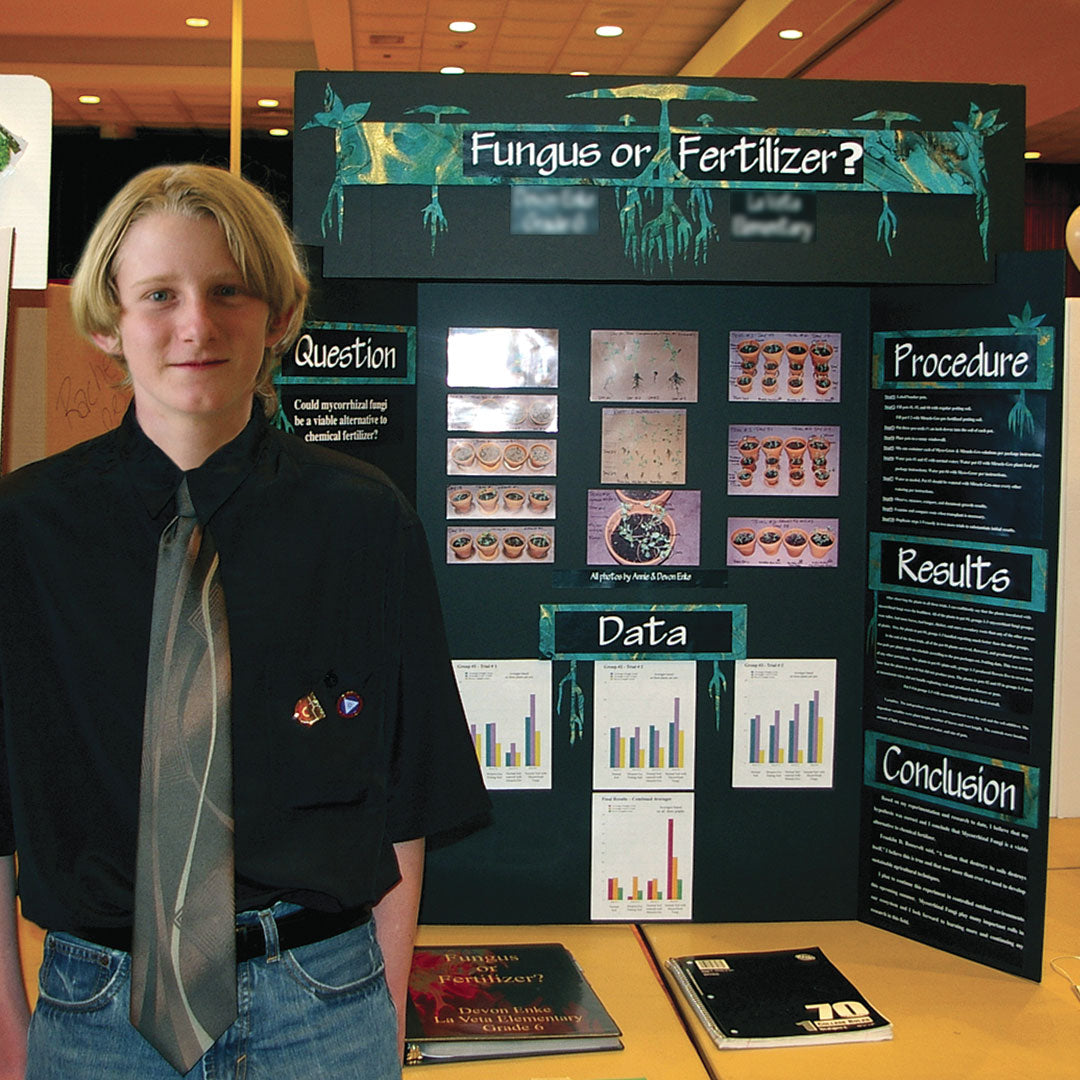
Future Fungonaut
Aspiring mycologist Devon contacted us a while back for some information regarding Fungi Perfecti’s MycoGrow® products, and mycorrhizal fungi in general, for a series of experiments he was conducting for his sixth grade Science Fair. His project, “Fungus or Fertilizer,” won first prize! Following are some excerpts from Devon's research paper.
by Devon (reproduced with permission)
Hypothesis
I hypothesize that Mycorrhizal Fungi is a viable alternative to chemical fertilizer and that plants inoculated with Mycorrhizal Fungi will grow as well, if not better than plants grown with fertilizer or in soil alone.
Experiment
Purpose: The purpose of this experiment is to compare the growth rate and health of plants started in plain soil, chemically fertilized soil, and soil inoculated with Mycorrhizal Fungi.
Procedure: I will acquire the following materials:
Myco-Grow™ (Mycorrhizal Fungi) Miracle-Gro Fertilizer™ Miracle-Gro Potting Soil™ Potting soil, Pea seeds, pots, and water.
I will then follow the below steps:
- Step#1: Label/Number pots.
- Step#2: Fill pots #1, #3, and #4 with regular potting soil. Fill pot # 2 with Miracle-Gro pre fertilized potting soil.
- Step#3: Put three pea seeds (½ an inch down) into the soil of each pot.
- Step#4: Place pots in a sunny windowsill.
- Step#5: Mix one container each of Myco-Grow & Miracle-Gro solutions per package instructions.
- Step#6: Water pots #1 and #2 with normal water; Water pot #3 with Miracle-Gro plant food per package instructions; Water pot #4 with MycoGrow™ per instructions.
- Step#7: Water as needed. Pot #3 should be watered with Miracle-Gro once every other watering per instructions.
- Step#8: Observe, measure, compare, and document growth results.
- Step#9: Examine and compare roots when transplant is necessary.
- Step#10: Duplicate steps 1-9 exactly in two more trials to substantiate initial results.
Results
After observing the plants in all three trials over the course of 65 days, I can confidently say that the plants inoculated with mycorrhizal fungi were the healthiest. All of the plants in pot #4, groups 1-3 (mycorrhizal fungi groups) were taller, had more leaves, had longer, thicker, and more secondary roots than any of the other groups of plants. Also, the plants in pot #4, groups 1-3 handled repotting much better than the other groups.

At the end of the three trials, all of the pot #4 plants survived, flowered, and produced peas (one to two pods per plant) right on schedule according to the pea packages est. fruiting date. This was not true of any other pots/plants. The plants in pot #1 (plain soil), groups 1-3 produced flowers five to seven days later that the plants in pots #4 but did not produce peas. The plants in pots #2 and #3 in groups 1-3 grew at inconsistent rates, did not handle replanting well and produced no flowers or peas. Pot # 4 in groups 1-3 with mycorrhizal fungi did the best overall.
Variables: The independent variables in this experiment were the soil and the soil additives. The dependent variables were plant height, number of leaves and root length. The controls were location, amount of light, temperature, amount of water, size of pots, and amount of soil in each pot.
The following graphs strongly support my hypothesis as well.




Conclusion
Based on my experimentation and research to date, I believe that my hypothesis was correct and I conclude that Mycorrhizal Fungi is a viable alternative to chemical fertilizer. Franklin D. Roosevelt said, "A nation that destroys its soils destroys itself." I believe this is true and that now more than ever we need to develop sustainable agricultural techniques.
I plan to continue this experiment in controlled outdoor environments this upcoming summer. Mycorrhizal Fungi play many important rolls in our ecosystem and I look forward to learning more and continuing my research in this field.
Great work Devon! Glad we could help!
— UPDATE —
In 2011, Devon further expanded on his research into the use of mycorrhizal fungi as a replacement for commercial fertilizers. The resulting report, "Mycorrhizal Symbiosis: Unlocking the Potential of Soil", is available for viewing online in Adobe Acrobat format. Many thanks to Devon for making this available!
